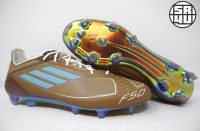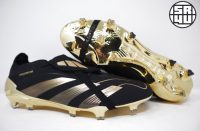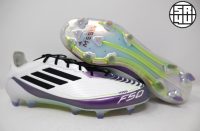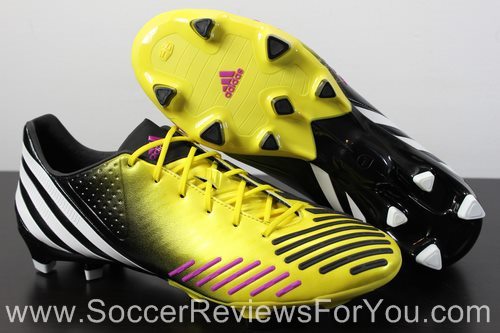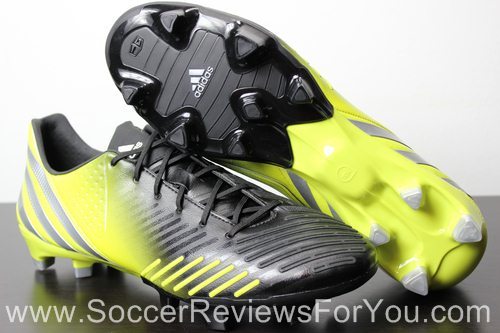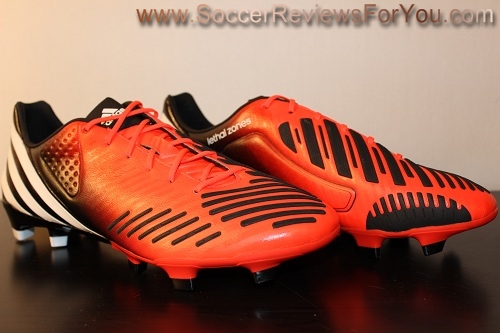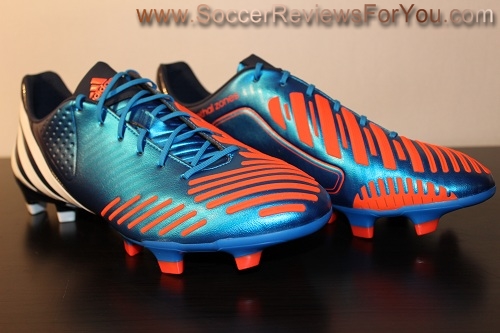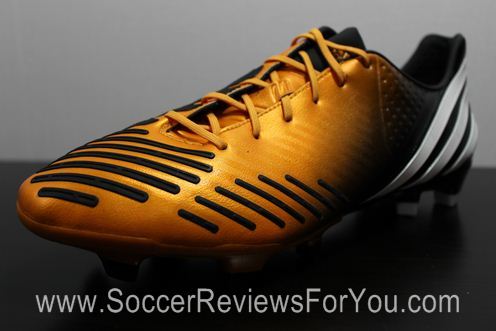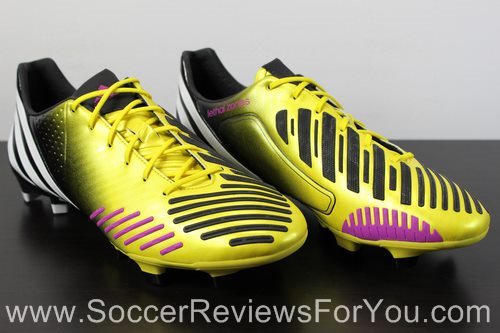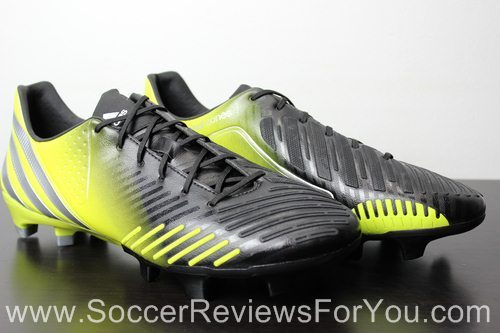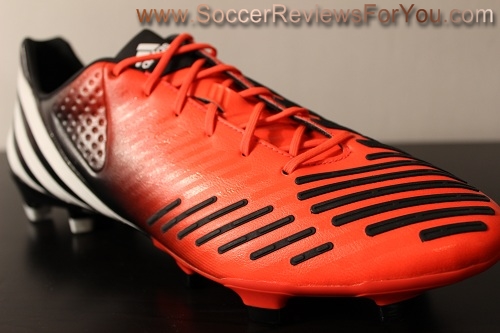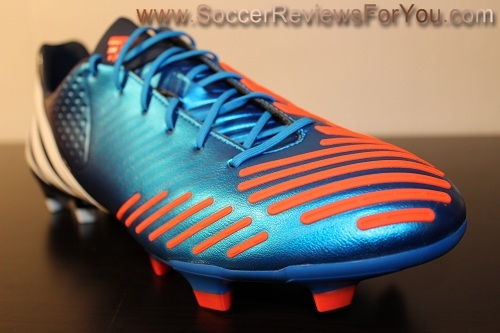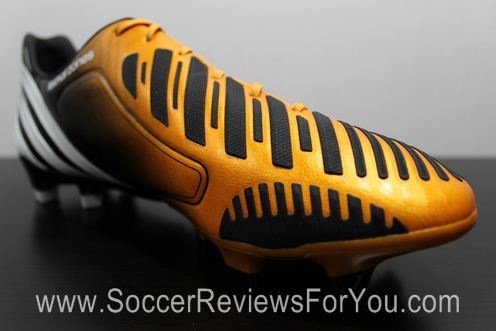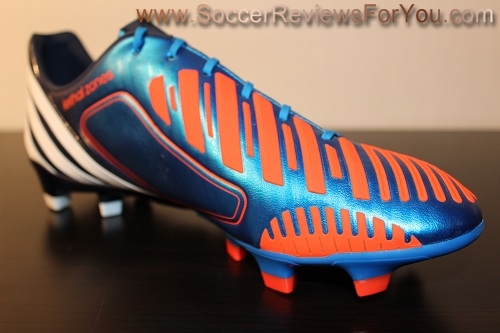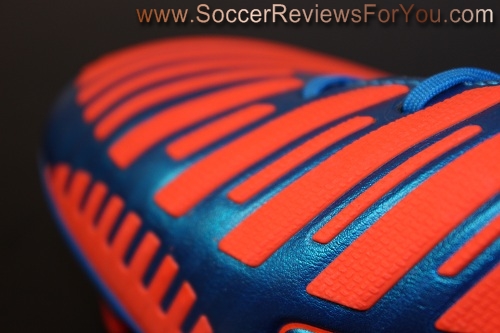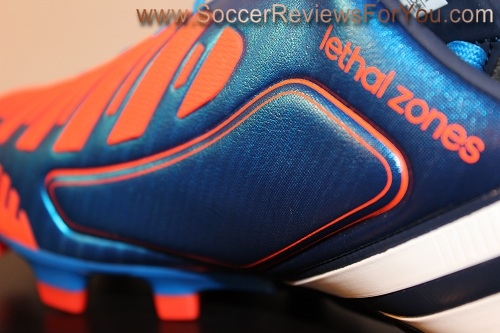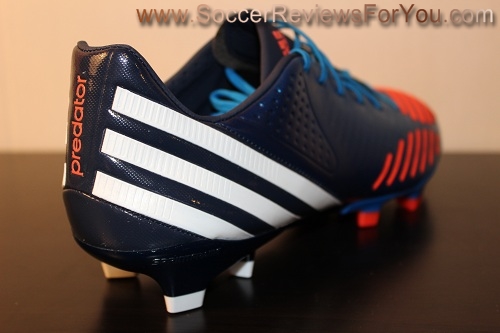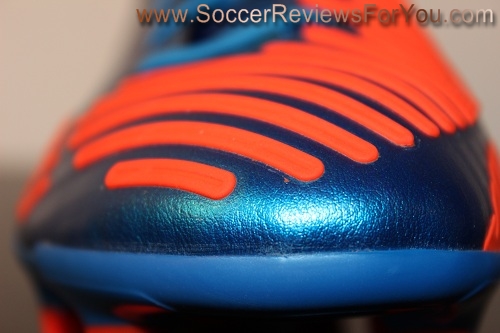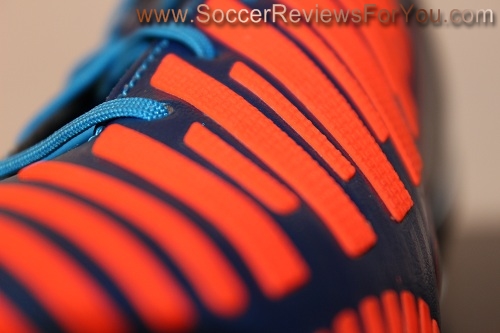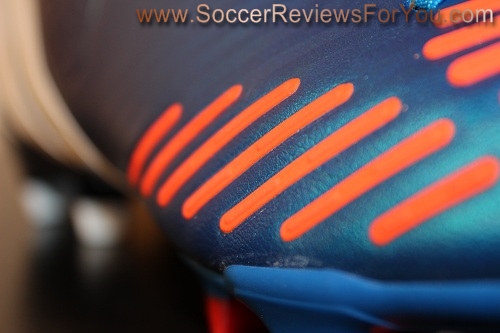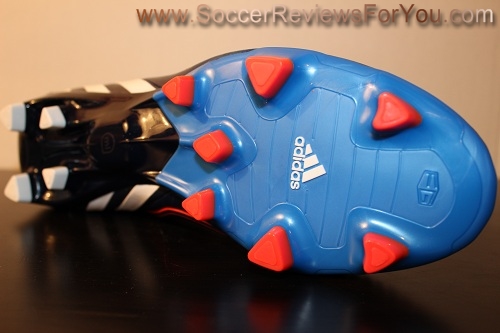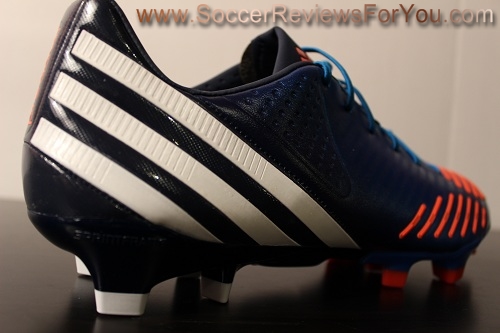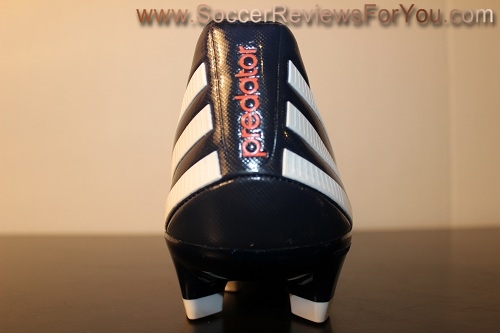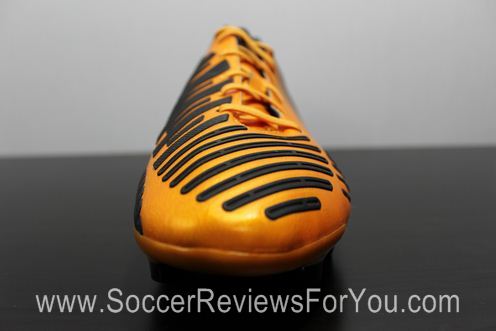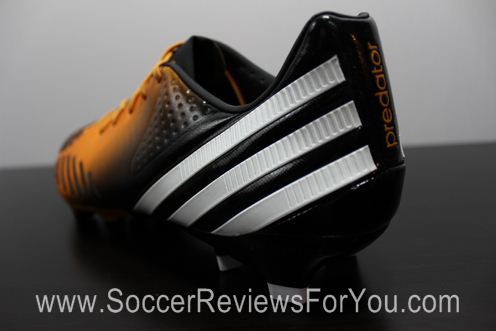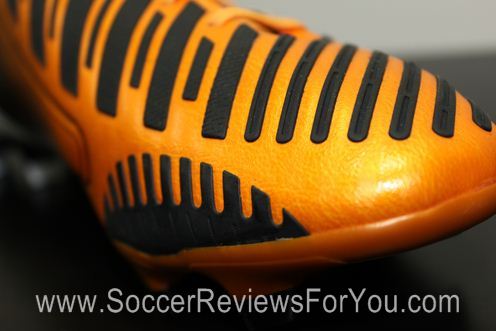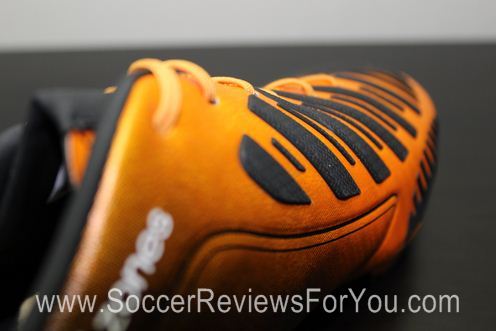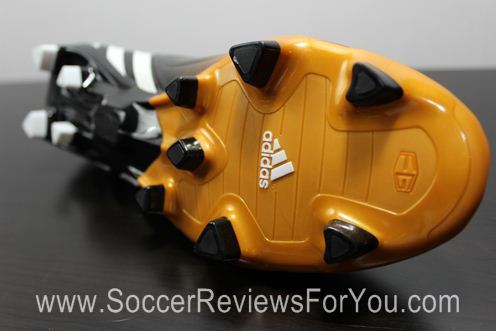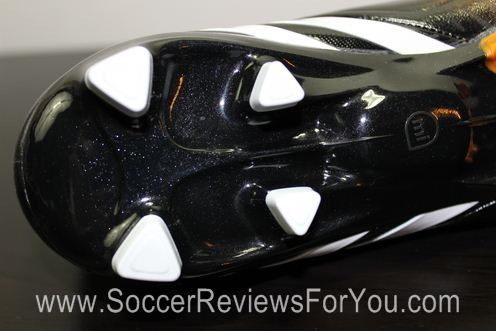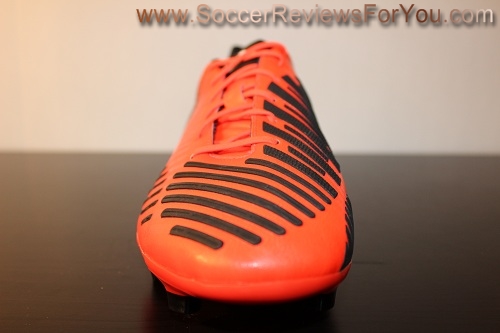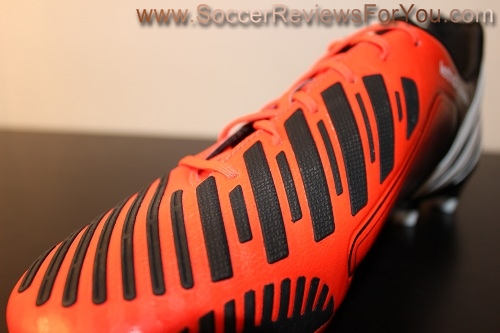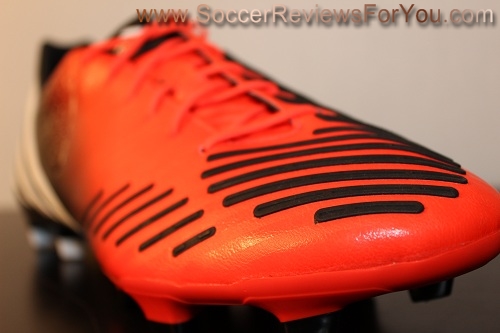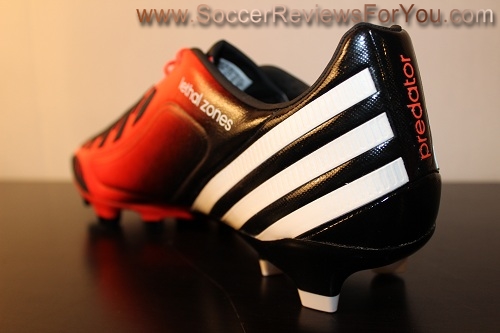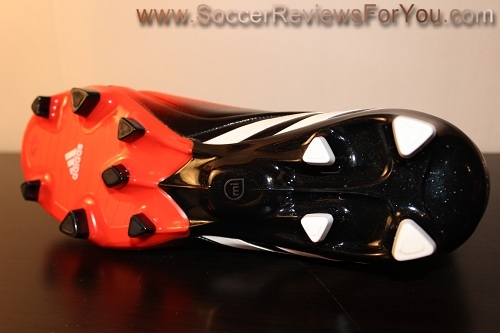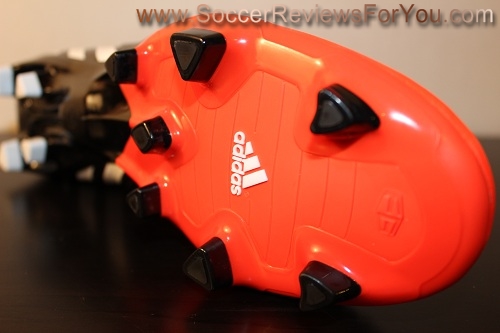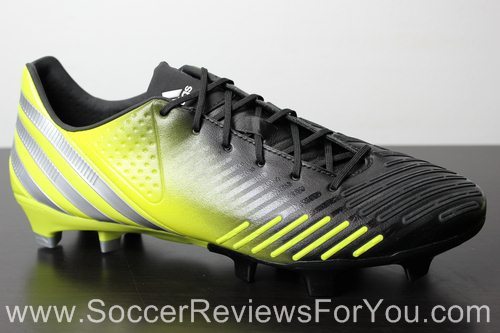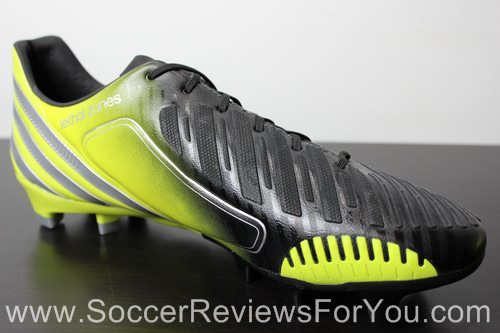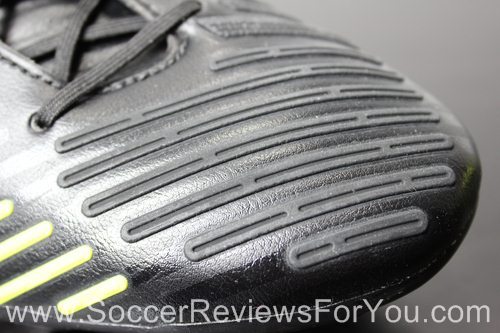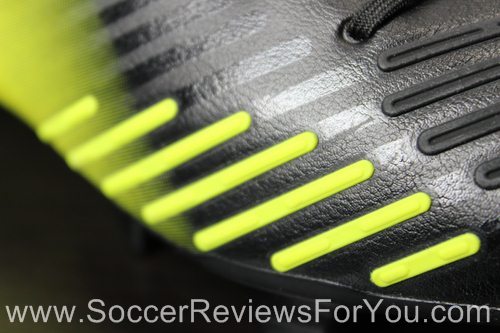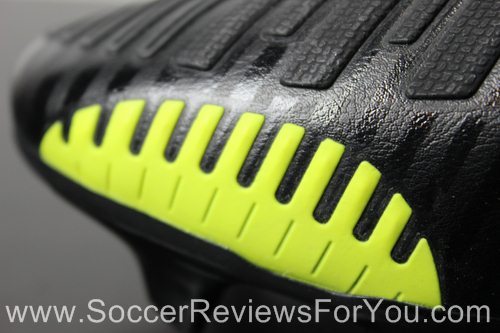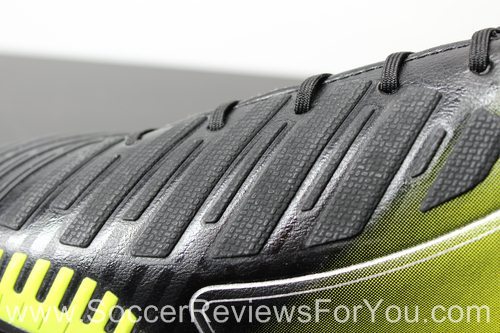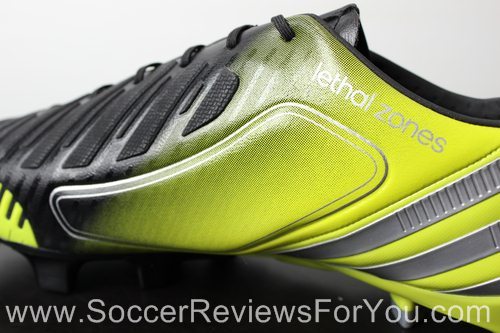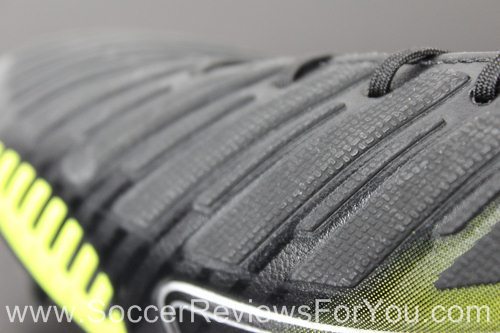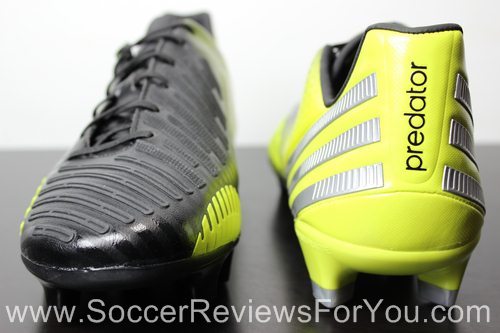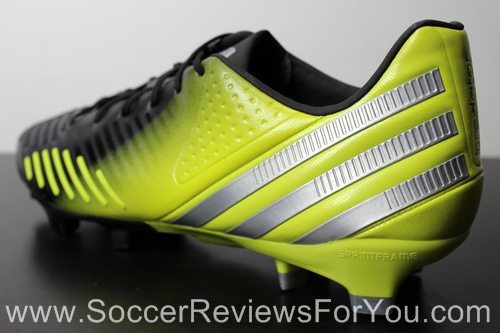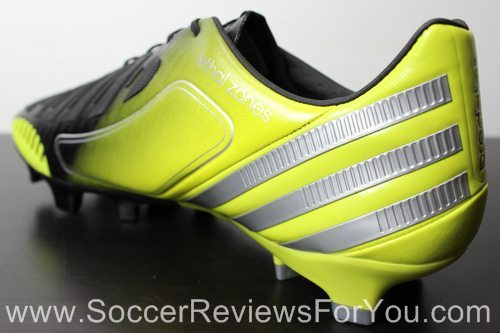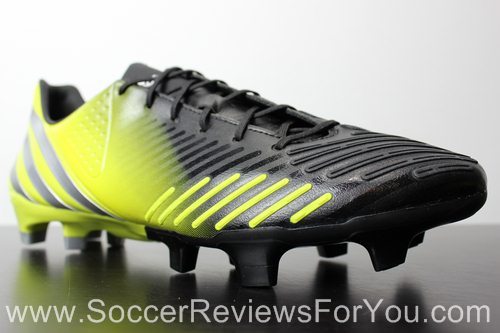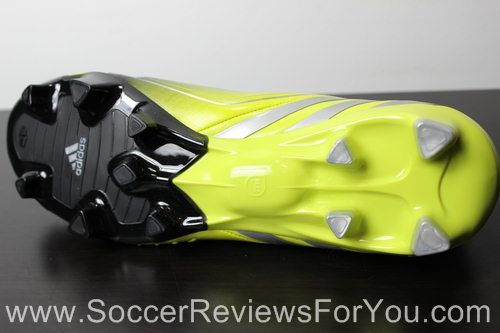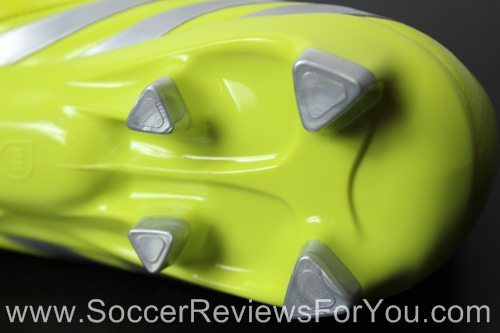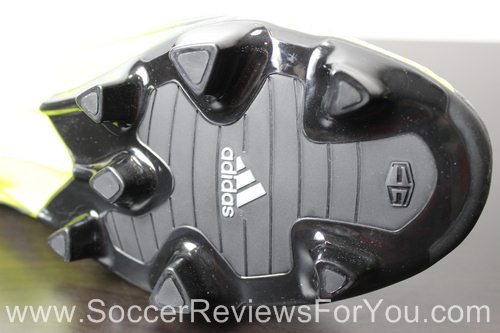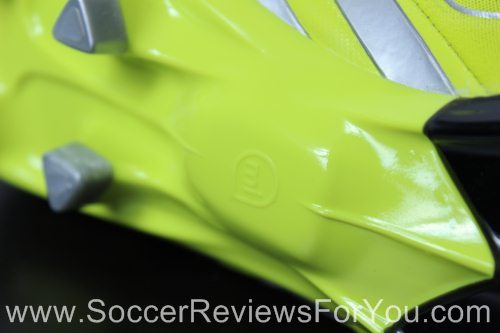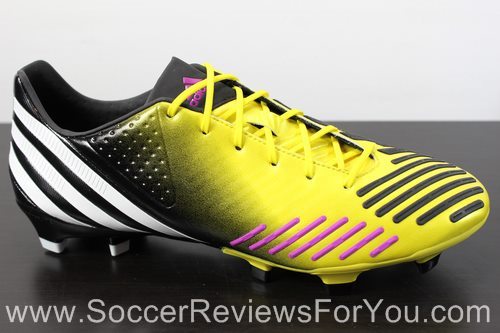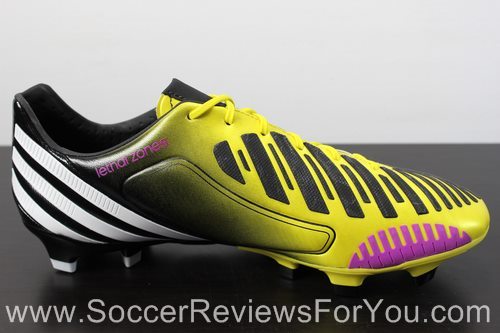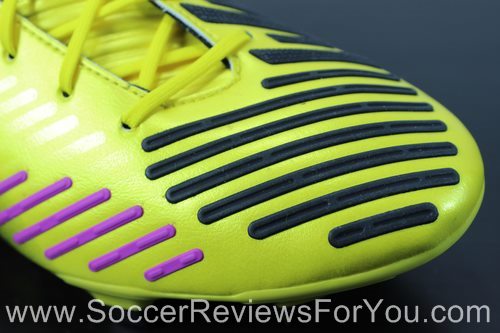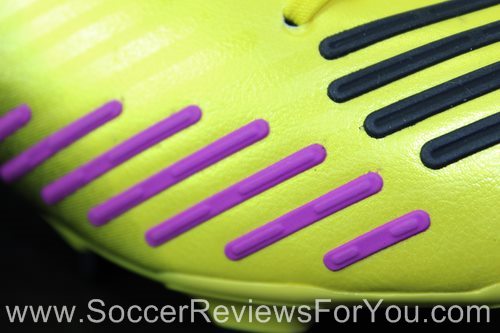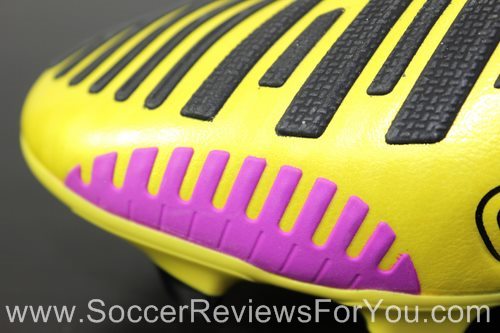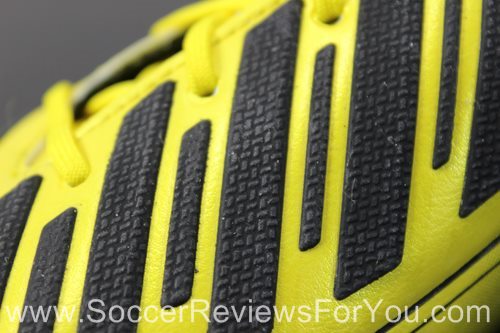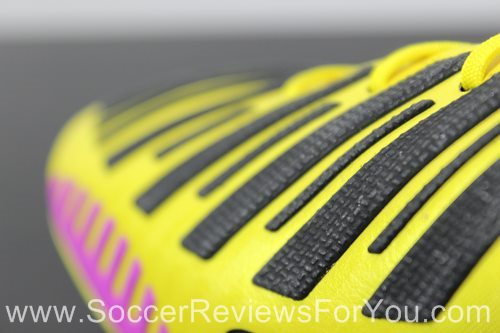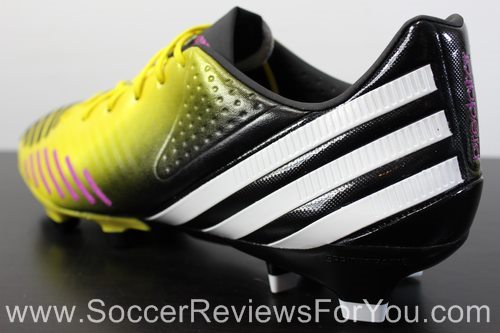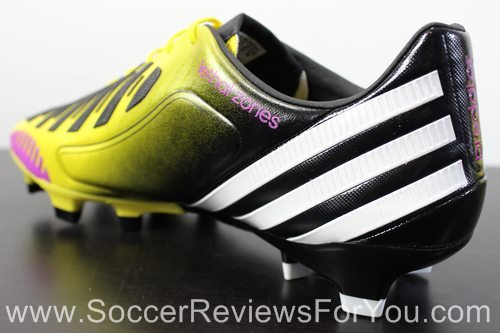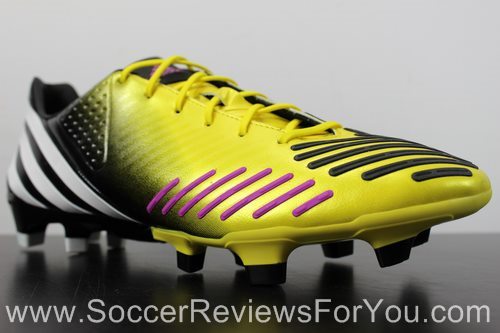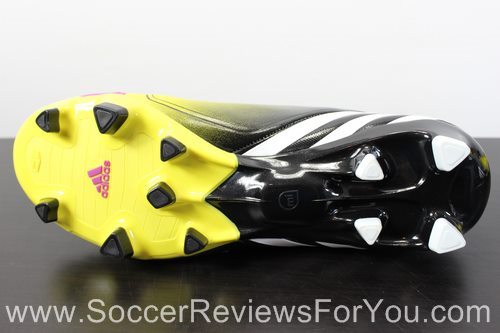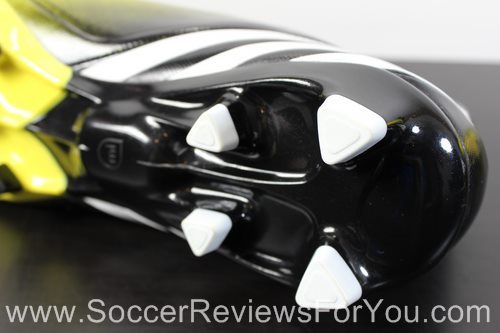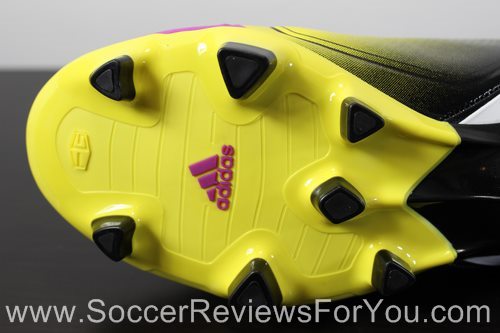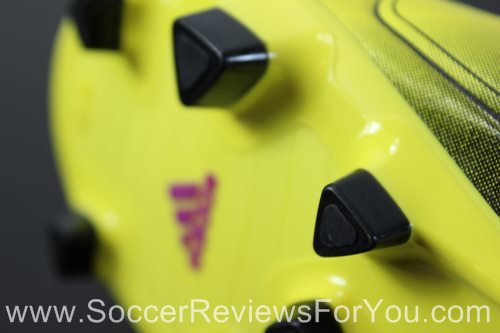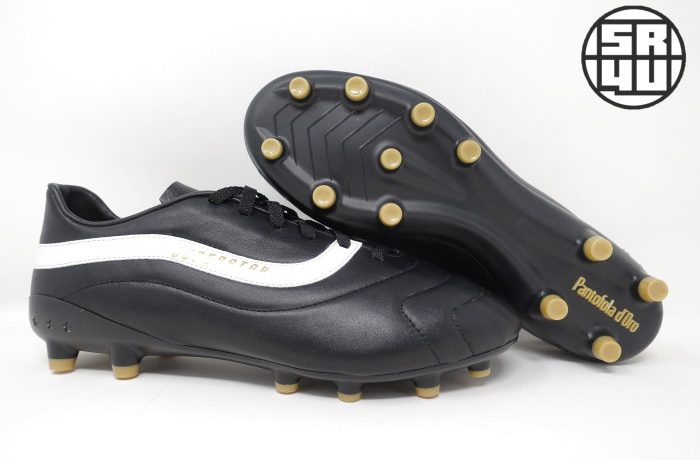The Predator LZ is Adidas’ latest model in the very popular Predator series. The LZ strays well away from what the Predator has stood for, for so many years, and goes in a direction that some are a big fan of, while others may not be as impressed. What makes the LZ so different from all of the past Predators is that is the first ever model to not be released with a natural leather upper as an option. The LZ is 100% synthetic, which has definitely turned off a lot of long-time Pred wearers. The choice to go with only synthetic may seem strange to some, but if you look at the actual design of the shoe, the whole concept of have “Lethal Zones” all over the shoe could not happen with a natural leather upper. The synthetic leather upper itself is pretty soft, especially for a synthetic, and is more comparable to something like a Kanga-Lite type of synthetic from Nike, rather than the very thin synthetics used on the adizero. There is no stitching on the upper either, so the LZ synthetic is not like past version of the synthetic Predators either.
The main problem that lot of companies have issues with when it comes to synthetic upper is that they are generally one-piece, which means that the shape has to be just right in order to ensure a quality fit. While there are still some minor issues with the shape of the synthetic adizero, the synthetic LZ has a much better shape in my opinion, allowing for a much tighter fit overall. The softness of the synthetic also allows for a small amount of stretching, so a slightly tighter fit from right out of the box is nothing to worry about. The soft synthetic also allows for a shoe that is pretty much game ready from right out of the box, with little to no break-in time. As far as how the shoe fits and feels, the LZ is just doesn’t seem to have that same solid feel to it that past Preds have had.
The heel still has a fairly deep fit to it, which is nice, but there is not a ton of stiffness in the sole of the shoe, which is something that the Predator line has been preaching for the past several models. Overall, the width of the shoe is about average to slightly wide through the mid foot, and is not overly wide in the forefoot and toe box, allowing the shoe to stretch to your foot just a little bit. One thing that could be an issue if you do have a wider forefoot is the Lethal Zone right on the inside of the forefoot, the “swerve” zone. The rubber element starts right from where the outsole joins the upper, and spans a couple of inches or so. The problem occurs if your foot is too wide, that small section on the upper, which is a critical stretch point on any soccer shoe, will not be able to stretch, which will cause some discomfort if your foot is too tightly pressed against it. I also noticed that the shape of the forefoot seems to be a little bit off where the “swerve” zone is, where that small section doesn’t seem to flow with the shape of the shoe, leaving some unwanted wiggle room if your foot is not the perfect width. Other than those issues, to shoe does fit well, given that your foot is not overly wide. The sizing on the LZ is fairly true. I wore my usual size 9US for review, and while they were pretty tight at first, especially in the toe box, the synthetic upper does have some stretch to it. I would definitely go with your regular size for the LZ and don’t worry if they fit a little tight at first, because they will stretch to a more comfortable fit.
Weight
Given that Adidas have stripped this Predator of most of the “Predator” features that we’ve come to expect from the line, I expected the shoe to weigh less than it actually does. Surprisingly, the LZ actually weighs a little more than the adiPower. While the weight difference is minimal, you have to take into consideration that the LZ is full synthetic and uses a thinner, more adizero-like soleplate and stud pattern, which one would think would make the LZ lighter. The end result is a shoe that weighs in at 8oz, which is by no means heavy, but without all of the solidness that a Predator is supposed to provide, I would expect the shoe to weigh less, not more. While I do realize that the weight of the shoe has very little impact on the overall performance, I just feel that if you are going to take away so many of the things that people loved from past Predators, there should be something else special about the shoe in another area, and in this case, I feel like this shoe should be lighter for what it is.
Traction
This is the first Predator in a while to not offer the classic Adidas bladed stud pattern. Adidas has instead opted to change all of their shoe lines to variations on the adizero stud pattern, which is the most popular shoe in the line. While this isn’t necessarily a bad thing, it may upset some long-time Pred wearers who have been wearing the same stud pattern for the last little while. This is another move away from the label of a “power” boot for the LZ, offering a stud pattern that is arguably as solid of a stud pattern as perhaps the older bladed one was. When I say “solid” I am speaking simply on the basis of shooting, with the bladed stud pattern offering more of a stable feel when planting your foot to strike the ball. With all of that aside, the LZ offers a stud pattern that is nearly identical to that of the adizero. The studs are all triangular shaped, offering somewhat of a combination feel between blades and conical studs. The stud pattern is best suited for firm to slightly softer ground, simply because the studs are slightly on the longer side, and because of the larger surface area of the studs, they will not penetrate the ground unless the ground is a little softer. Given that the conditions are right, the stud pattern performs and feels very good. It offers plenty of grip when pushing off for a sprint, which is great. This is a stud pattern that is definitely usable on turf, but again, I do find the studs to be a little on the long side. If you’ve worn the adizero, which many have, than the stud pattern on the LZ should feel exactly the same for you.
Touch
The LZ has really gone over the top with the use of rubber on the upper. If you have seen any of the marketing, which I am sure that you probably have, the LZ, which stands for “Lethal Zones” is what the new Predator is all about. The idea is that a blank white shoe was given to all of the top professionals, and they were asked to circle the spots on the shoe that they use most. Through comparing all of the results, five zones were established and placed on what is the new Predator. While I do think that this is a good idea and everything about it does make sense, the of rubber across the entire upper of the shoe is nothing new to soccer shoes, it has just never been marketed in such a way that got people so excited. One shoe that comes to mind that offered just as much rubber on the upper is the Nike T90 Laser II, for those of you who can remember back a few years. So, as expressed by Adidas, each of the five “Lethal Zones” serves its own unique purpose, each specifically designed for the following: passing, striking the ball, swerve, dribbling and control. The LZ is not necessarily the first of its kind, but it is the first to be marketed a shoe that can be thrown into various categories of marketing.
So, how is the touch on the LZ? The answer to that question is that some will love it, while others will hate it, and it’s that simple. If you are really into having a plain leather upper or are not a fan of having a lot of grip on the ball, straight away, the LZ is not for you. The instep features the “passing” zone, which is a section with a layer of memory foam on the upper. The foam is on the thinner side, but is definitely is noticeable and is probably my favorite part of the shoe. It offers just a little bit of extra padding when touching or passing the ball with the instep, but is nothing overly different in terms of feel than what you can get from a quality leather upper. The “swerve” element is positioned on the instep of the forefoot, and while the main purpose that it is supposed to serve is for shooting, it is going to be the main thing that is going to take getting used to on the LZ. The element is very grippy, and because it is positioned in easily one of the most commonly used spots of the foot, it will take some adjusting to get used to it. This is also something that I am not sure about with the LZ. Why should I have to change my technique in order to feel comfortable with my touch on the ball just because of the shoes on my feet? If you are someone who tends to push or drag the ball when playing, something that I personally do enough of, the “swerve” element will not exactly allow for that because of how much grip it provides. While I eventually did find myself getting used to it after 3 to 4 hours of use, I can honestly say that it is something that I just really didn’t like when I first started wearing the LZ. Like I said, I did get used to it, but I did find myself touching the ball differently in the LZ than I would in another shoe. The LZ is not going to offer more control, and no shoe will, but it will offer a lot more grip on the ball, which some will like and others will not.
The next zone on the shoe that is touch related is the “First Touch” zone, located right on top of your toes. The idea is again, to provide more grip on the ball, which is supposed to make for better control. The strips of rubber on this zone are made of a much harder rubber and provide very little grip against the ball. It is easily the least noticeable rubber element on the boot, and really doesn’t provide any type of unique feel. The last touch-related element on the shoe is the “Dribble” element, located on the outside of the forefoot. It is made up of several small, thin strips of rubber, making for a little bit of extra grip on the ball when dribbling with the outside of the foot. This again is something that you are either going to love or hate. This was never an area of the foot that I ever felt that extra grip was necessary, so like I said, if you tend to drag the ball rather than push it, you might not be a fan of the extra grip.
To sum up this very lengthy explanation of the feel that the Predator LZ provides, I can honestly say that I came to like the feel of the LZ. I am not a big fan of having rubber elements on parts of the shoe that are regularly touching the ball when you are not shooting, and I am still big fan. Once I did get used to the LZ, and there does seem to be somewhat of a learning curve so you aren’t stumbling over the ball from all of the extra grip, I did come to like the touch of the LZ to an extent. Do I think that the LZ will help you with your touch? The answer is very simply no, and for some, the extra grip will just frustrate you.
Shooting
Given that this is a Predator, a shoe that has always been about shooting, you would expect the newest version of the Predator to provide a solid feel for shooting. We’ll start with the only “Lethal Zone” that I have yet to mention, and that is the “Drive” zone. This is the main striking element located right on top of the foot, spanning about the same surface area as the previous version of the Predator, the adiPower. Like the overall make up of the shoe, the striking element is also somewhat stripped down. Even though the striking elements is the thickest rubber on the shoe, it is still fairly thin in comparison to most striking elements that we see on a lot of “Power” boots on the market. The problem that I have with the striking element is that it doesn’t provide that solid surface that I feel a striking element should have. The reason for this is because the rubber sits on top of the actual upper of the shoe, rather than being an actual cut out in the upper, again like the adiPower. The result of having the striking element over top of the upper is that you get more of a cushioned feel when striking the ball rather than a direct impact, if that makes any sense. This is a similar complaint that I had with the Nike T90 Laser IV. This does not mean that you are not going to be able to strike the ball as hard, you just won’t get that feel that I think that a striking element should provide. The second striking element on the LZ is the previously explained “Swerve” zone. Like I explained earlier, it does provide some extra grip, but nothing that is going to allow you to curl the ball any more than you would normally be able too. Again going back to the Laser IV, I feel like the fins that hang off on the instep provide just as much, if not more grip than the LZ swerve element. Keep in mind that rubber elements will not allow for more spin on the ball, it will just allow for more spin on the ball without as good of a technique. Essentially it is a helper, but if you can’t curl the ball in the first place, no striking element on earth is going to help you. Another thing to keep in mind that the lightweight construction of the now adizero-like soleplate does not include the Adidas powerspine that we have seen on the past couple of Predators. It is definitely not stiff as what you may be used too if you are a long-time Pred wearer, but is not going to hinder the actual performance of the shoe, or your shooting ability. The LZ is a step away from the “Power” boot label that it has carried for so many years, and you can definitely tell, especially if compared to past models of the Predators.
Protection
The LZ is definitely the thinnest of the Predators, especially considering the brand new synthetic upper. The upper is on the thinner side, but is covered in plenty of rubber strips. While the rubber strips do add some protection to the shoe, I definitely wouldn’t call the LZ an above average boot in terms of protection. There is an internal heel counter, which is going to provide some decent protection from the back, but should you get stepped on, you will still feel most of the blow. The LZ will not feel like you are out there in your socks, and should provide enough protection for most.
Durability
To answer a question that a lot of people have asked, no, the rubber elements do not fall off. Part of the reason why the LZ is full synthetic is because the elements require a flat, even surface in order for them to stick. Given that the shoe is synthetic, there is no maintenance required, which is always a plus. I had no issues with sole separation at all, and am fairly confident that they will last a full season of use, given that you stay away from turf. Keep in mind that using any Firm Ground shoe on turf, a surface that it was not designed for, you will shorten the lifespan of your shoe significantly.
The Verdict
As you can tell, there is a lot to take in with the Predator LZ, and it really took a lot of thought to truly sum up my final thoughts on this shoe. Going into this review, I expected not to like the LZ, and when I first tried them, I still didn’t like them. As explained, once you do get used to them, I didn’t mind the extra grip that they provided, but again, I am not sure that a soccer shoe should have a learning curve. I would not say that the LZ provides a feel that we have never seen before, but given what is currently on the market, they are unique. The determining factor as to whether or not the LZ is for you is really based around your preferences towards the amount of grip that a soccer shoe should provide against the ball. If you think that you will like the extra grip, the LZ may be for you. If not, I would definitely look elsewhere. The LZ is a good shoe, but it is not for everybody.
| Comfort/Fit | 8 out of 10 |
| Weight | 8 out of 10 |
| Traction | 8 out of 10 |
| Touch | 8 out of 10 |
| Shooting | 9 out of 10 |
| Protection | 8 out of 10 |
| Durability | 8 out of 10 |
| FINAL SCORE | 57 out of 70 or 81% |


